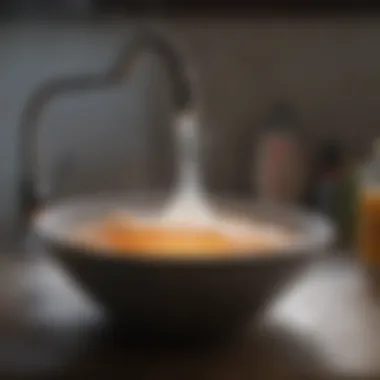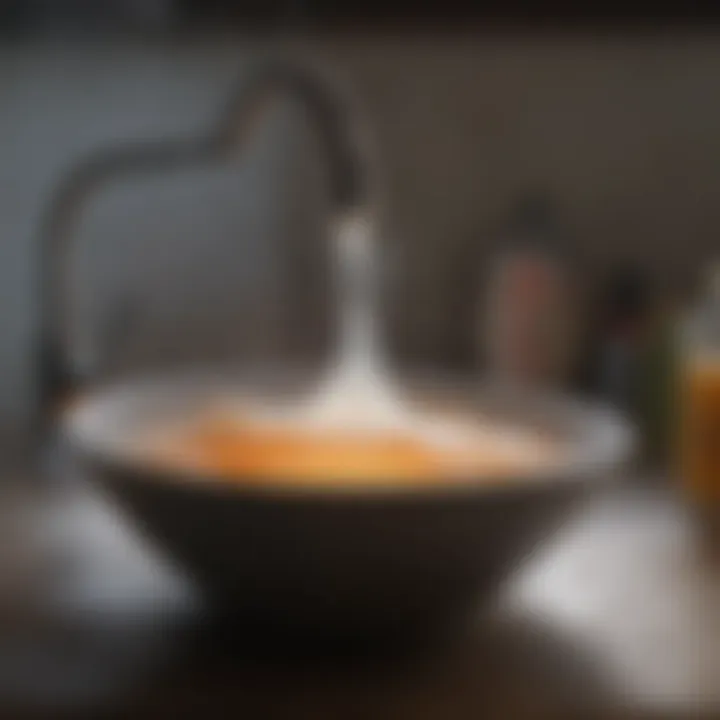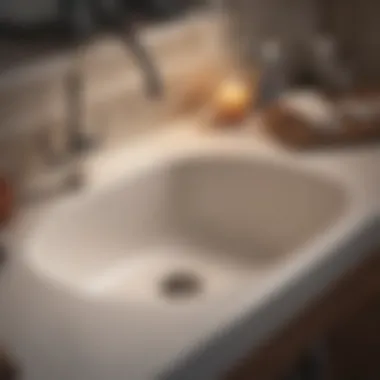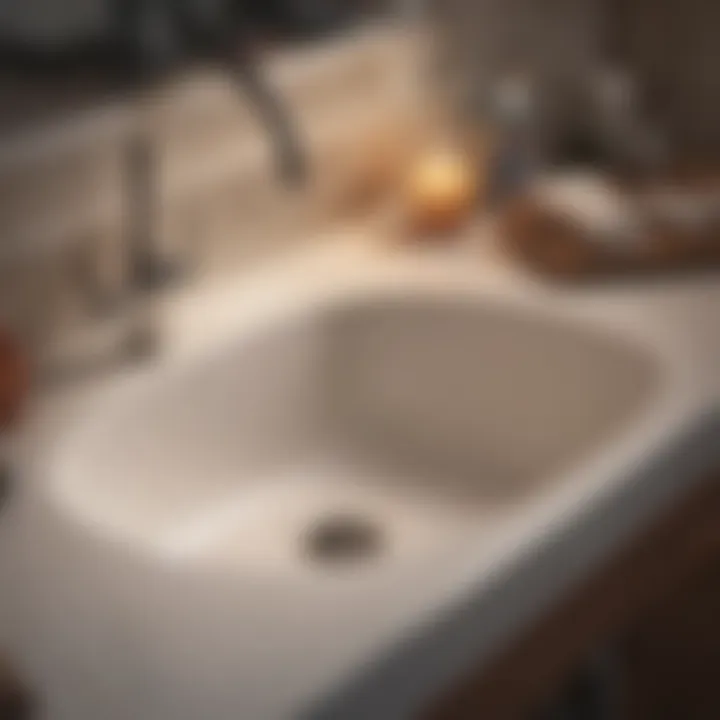Effective Home Remedies for Clogged Kitchen Sink


Intro
A clogged kitchen sink is a common issue in many households. The buildup of debris, grease, and food particles often leads to frustrating blockages that can disrupt daily routines. Understanding how to effectively address such blockages can save both time and money. This article delves into practical home remedies using natural ingredients and methods that can efficiently resolve the problem without professional help.
Homeowners will find step-by-step instructions for various techniques to clear their sinks. Additionally, the article offers preventative measures to help avoid future clogs. With a focus on accessible and environmentally friendly solutions, this discourse aims to educate readers on effective kitchen maintenance.
Feature Spotlight
Clogged sinks do not only require quick fixes; they also present an opportunity to improve overall kitchen function and hygiene. Understanding the essential methods to relieve blockages can enhance the kitchen's usability.
The Causes of a Clogged Sink
Before diving into remedies, knowing the typical culprits behind kitchen sink blockages can be enlightening. Common causes include:
- Accumulated grease from cooking.
- Food scraps that are sent down the drain.
- Coffee grounds and other solids that do not dissolve.
- Hair and soap residue in the drain pipe.
Identifying the problem is the first step toward implementing effective solutions.
Practical Home Remedies
With the causes established, here are some remedies that can clear a clogged kitchen sink.
Baking Soda and Vinegar
Using baking soda and vinegar is one tried-and-true method. The two react to each other, creating fizzing bubbles that help dislodge debris.
Steps to follow:
- Pour about half a cup of baking soda down the drain.
- Follow it with half a cup of white vinegar.
- Allow the mixture to sit for approximately 30 minutes.
- Lastly, flush the drain with boiling water.
Salt and Hot Water
In addition to the previous method, a combination of salt and hot water may also provide relief. Salt acts as a natural abrasive, helping to scrub blockages away.
Instructions:
- Pour half a cup of table salt into the drain.
- Wait around 10 minutes for the salt to take action.
- Finally, flush with boiling water to clear away any loosened debris.
Dish Soap and Hot Water
Utilizing dish soap combined with hot water is another excellent tactic. The soap helps break down grease build-up.
Procedure:
- Pour a generous amount of dish soap down the drain.
- Follow it with a pot of boiling water.
- Let it sit for a few minutes before flushing again.
Using these remedies not only helps clear the blockage but also keeps the plumbing system functioning well.
Preventative Measures


To prevent future sink clogs, consider these tips:
- Regularly dispose of food scraps properly instead of using the sink.
- Clean the drain with warm, soapy water weekly.
- Avoid pouring grease down the drain.
- Use a sink strainer to catch debris.
By addressing the problem promptly and implementing effective remedies, homeowners can maintain their kitchen sinks' functionality. Being proactive helps to avoid messy and inconvenient situations in the future.
Prelims
A clogged kitchen sink can be an unwelcome disruption in daily life. It impedes normal activities and often leads to frustration. Understanding the importance of addressing this issue efficiently is crucial for every homeowner. In this article, we will explore effective home remedies to unclog your kitchen sink using simple and natural ingredients.
From utilizing baking soda to completely avoiding professional plumbing services, the benefits are multiple. First, home remedies are often more cost-effective than hiring a plumber. They utilize materials and ingredients that are typically found within the household, making it convenient. Moreover, these methods are environmentally friendly, reducing the need for harsh chemicals that could harm both plumbing and the ecosystem.
In addition to offering practical solutions, this article scrutinizes various causes of sink clogs. Addressing the root of the problem is paramount to long-term maintenance. It’s not just about fixing the current blockage; it's also about preventing future incidents. With proper knowledge and methods, homeowners can cultivate a healthier kitchen environment.
Ultimately, this comprehensive guide aims to arm you with the skills to effectively manage kitchen sink clogs. Whether you are a seasoned homeowner or a novice, the insights shared here are designed to be practical and informative. The aim is not just immediate relief but fostering an understanding of good kitchen maintenance practices.
Understanding Sink Clogs
Understanding sink clogs is essential for homeowners facing frequent plumbing issues. It highlights not just the symptoms, but delves into the underlying causes of blockages. By grasping these concepts, one can adopt preventive measures and apply effective remedies when problems arise. This knowledge empowers individuals to address issues efficiently, reducing reliance on professional services and saving costs in the process.
Common Causes of Kitchen Sink Clogs
Various elements can contribute to kitchen sink clogs. Some of the most prevalent causes include:
- Food Particles: Tiny bits of food can accumulate, especially if a garbage disposal is not used properly. Over time, food residue can cause blockages.
- Grease Build-Up: Grease from cooking can harden in pipes, making it a significant cause of clogs. It sticks to the inner walls and traps other substances.
- Soap Scum: Soap can combine with minerals and other residues, leading to blockages.
- Foreign Objects: Items such as utensils or plastics may accidentally fall into the sink, creating blockages.
Each of these factors can play a role in creating a clogged sink, and knowing them allows for better management.
The Impact of Food Waste
Food waste is not just a nuisance; it can severely impact sink functionality. When disposed of in large quantities, food waste clogs the drain over time. For those not using a disposer, large scraps can gather in the P-trap, leading to a stagnant flow. Moreover, leftover food can decompose, leading to unpleasant odors and attracting pests. An understanding of how food waste interacts with plumbing can encourage better disposal habits.
Role of Grease and Oil
Grease and oil are often overlooked as a cause of clogs. They accumulate over time, leading to significant blockages. Food oils tend to solidify as they cool, sticking to pipe walls. This accumulation can create a blockage tougher than food particles. It acts like a glue, trapping waste until it is almost impossible to clear without professional help. Knowing the detrimental role of grease and oil can prompt users to dispose of these substances correctly rather than rinsing them down the sink.
Importance of Drain Maintenance
Regular drain maintenance can prevent clogs before they start. Simple practices, such as using strainers to catch food particles and periodic cleaning with natural solutions, can contribute to a longer-lasting plumbing system. Maintaining drain health reduces the effort needed to resolve future clogs, and it enhances overall kitchen hygiene. Proactive checks can identify small problems before they escalate, leading to a more efficient kitchen environment.
Initial Assessment of the Clog
Assessing the clog in your kitchen sink is an essential first step toward resolving the issue effectively. Without this initial evaluation, you can spend time and resources on remedies that may not address the real cause of the blockage. Knowing whether it is a minor or severe clog can dictate the best approach to take moving forward. Moreover, this assessment might save you from unnecessary professional services, which can be costly and time-consuming.
An accurate assessment includes determining the severity of the clog and inspecting for visible blockages. Both areas provide critical insights into the current plumbing situation.
Identifying the Severity of the Clog
To effectively tackle a clogged kitchen sink, identifying the severity of the clog is necessary. You can do this by observing the behavior of the water when you try to drain it. Here are some signs to look for:
- Slow drainage: If water drains slowly, it indicates a partial blockage. It might be an issue that can be resolved with home remedies.
- Standing water: If the sink fills with water and does not drain even a bit, this suggests a more severe clog.
- Unpleasant odors: Foul smells can signal decomposition of food particles caught in the drain, indicating the blockage may need quick attention.
- Multiple drain issues: If other drains in the home, such as the dishwasher or the laundromat, exhibit similar issues, it might suggest a more systemic problem.


Understanding these signs can assist in deciding what method to use for remedying the clog.
Checking for Visible Blockages
Once you have assessed the severity, the next step is checking for visible blockages. This step can sometimes reveal the cause more directly. Here are practical tips to look for:
- Remove the drain cover: If applicable, take off the drain cover to inspect the drain more closely. Food particles, hair, or other debris may be immediately visible at this stage.
- Use a flashlight: A good source of light can help identify any blockages deep within the pipes that are not immediately visible.
- Check the disposal unit: If your kitchen has a garbage disposal, inspect it as well. Sometimes, items can get trapped inside, inhibiting proper function.
- Simple plumbing tools: Using a snake or a long object used gently can help fish out any blocking items. However, be cautious not to damage the plumbing.
By systematically checking these areas, you can better understand the blockage's nature and decide on the best remedy to employ afterward.
Practical Home Remedies
Practical home remedies are essential for addressing kitchen sink clogs effectively. When a sink gets clogged, it disrupts daily activities, such as cooking and cleaning. Tackling these issues with home methods is not only cost-effective but also less invasive than professional plumbing. Utilizing natural and easily accessible ingredients can provide immediate relief while minimizing environmental impact.
In this guide, we will explore various methods to address sink clogs effectively. Each remedy has distinct advantages and deployment instructions. Understanding these remedies allows for proactive maintenance, potentially saving time and expense.
Baking Soda and Vinegar Method
The combination of baking soda and vinegar is a renowned method for clearing minor clogs. Baking soda acts as a base while vinegar is acidic. When mixed, they create a reaction that can break down build-up in pipes. To use this method, start by pouring one cup of baking soda down the sink drain. Then follow with one cup of vinegar. Allow the mixture to sit for about 30 minutes. Finish by flushing the drain with hot water. This method is effective for light blockages caused by grease and debris.
Boiling Water Technique
Boiling water is one of the simplest yet effective methods to dislodge clogs. This method is especially helpful when grease has solidified in the pipes. Start by heating water in a kettle or pot until it reaches a rolling boil. Carefully pour the boiling water directly into the sink. Repeat this step two to three times for stubborn clogs. This method offers a straightforward and fast solution; however, it should not be used on plastic pipes as it could cause damage.
Salt and Baking Soda Solution
A mixture of salt and baking soda can enhance the unclogging process. Salt serves as an abrasive agent, helping to scrub the insides of the pipes, while baking soda works to break down debris. To try this method, blend equal parts salt and baking soda together. Pour this mixture down the drain, followed by boiling water. Allow it to sit for 15 minutes before flushing with more hot water. This method is effective against both grease and inorganic materials.
Using a Plunger Effectively
When home remedies fail, using a plunger may be the next step. A plunger creates a vacuum, helping to dislodge clogs. Begin by ensuring that there is enough water in the sink to cover the plunger's cup. Place the plunger firmly over the drain, creating a seal. Push down and pull up rapidly for around 10 to 15 seconds. Repeat if necessary. This method is practical for solid blockages and ensures immediate action without chemical products.
The Dish Soap Trick
Dish soap can be very effective at loosening greasy clogs. Pouring about half a cup of dish soap into the drain can help break down any fat residues. After letting the soap sit for about 10-15 minutes, follow with hot water. This simple trick works particularly well in partnership with boiling water, enhancing the overall effectiveness.
Wet/Dry Vacuum Application
Using a wet/dry vacuum can be an excellent strategy for severe clogs. If you have a vacuum with wet capability, place the hose over the drain and create a strong seal. Turn on the vacuum to suck out the blockage. This method can effectively remove solid materials that are otherwise difficult to handle. The wet/dry vacuum is a long-term investment for regular maintenance and quick resolution.
Always exercise caution with all these methods. If clogs persist, professional help may be required.
These practical home remedies offer a sustainable approach to handling kitchen sink clogs. By applying these methods, homeowners can enhance their plumbing care and reduce the risk of future blockages.
Preventive Measures
The importance of preventive measures in maintaining a healthy kitchen sink cannot be overstated. Often, homeowners confront clogs and blockages resulting from a lack of foresight in their sink maintenance practices. Taking proactive steps can not only save time and money but also prevent more serious plumbing issues that may necessitate professional intervention. Regular maintenance of your kitchen sink is essential for enhancing the overall functionality of your home’s plumbing system.
Regular Drain Cleaning Routine
Implementing a regular cleaning routine is vital for keeping your kitchen sink clear from debris and potential blockages. This routine can involve simple activities such as pouring boiling water down the drain once a week. The heat helps dissolve grease and food particles that may accumulate in the pipes. Additionally, using a mixture of baking soda and vinegar can be an effective natural cleanser. When combined, these two ingredients create a fizzy reaction that helps to dislodge minor build-ups when allowed to sit in the drain for around 30 minutes.


- Establish a Schedule:
- Use Natural Cleaners:
- Choose specific days for your cleaning tasks. Consistency aids in forming helpful habits.
- Consider marking it on a calendar or setting reminders on your smartphone.
- Baking soda and vinegar work efficiently together.
- Regular maintenance with these can help reduce reliance on chemical cleaners, which may harm plumbing over time.
By integrating these actions into your routine, you create a barrier that hinders the development of major clogs in your kitchen sink.
Proper Disposal of Food Waste
Proper disposal of food waste is another essential aspect of preventing kitchen sink clogs. Many homeowners underestimate the importance of how they discard waste. Certain items should never be introduced to your sink drainage system. This includes grease, fibrous vegetables, eggshells, and coffee grounds. These materials can easily accumulate and cause blockages, leading to unpleasant plumbing situations.
- Common Offenders to Avoid:
- Use a Waste Disposal Unit:
- Grease and fats should be disposed of in a suitable container, not poured down the sink.
- Stringy vegetables like celery can wrap around components within the pipes, creating clogs.
- Coffee grounds can compact and form stubborn blockages over time.
- If possible, consider installing a garbage disposal system. While this does not eliminate the risk of clogs, it can significantly reduce the majority of food waste entering the pipes.
Understanding how to dispose of food waste correctly can extend the lifespan of your plumbing installations and ensure a more efficient, less problematic sink operation.
"Preventive measures are not merely a choice; they are an essential part of home maintenance that contributes to the overall efficiency of your home's plumbing system."
By being diligent and informed, homeowners can take significant steps to avoid clogs in their kitchen sinks, thereby creating a more satisfactory cooking environment.
When to Seek Professional Help
When addressing a clogged kitchen sink, many homeowners initially prefer to tackle the issue on their own. However, knowing when to seek professional help is crucial for maintaining both the functionality of the sink and the overall plumbing system. If a clog persists despite using effective home remedies, it may signal deeper problems that require expert intervention. Here are key points to consider when evaluating the need for professional assistance.
Signs Indicating Serious Problems
Several indicators can help determine the severity of plumbing issues. If you notice the following signs, it may be time to call a professional plumber:
- Recurring Clogs: If your kitchen sink becomes clogged repeatedly within a short period, it often means there is a more significant blockage in the plumbing system.
- Unusual Sounds: Gurgling sounds when draining water can indicate trapped air in the pipes or an obstruction further along in the drainage line.
- Slow Draining: A consistently slow-draining sink that worsens over time may require professional assessment. This could be a symptom of buildup somewhere in the system.
- Water Backup: If water begins to back up into other drains, like your dishwasher or another sink, it suggests a larger issue with the drainage system that needs immediate attention.
- Foul Odors: Persistent bad smells emanating from the sink could be a sign of decaying food or a serious leak, which necessitates professional expertise.
Consider engaging a plumber if any of these signs persist. Ignoring them may lead to more complicated and costly repairs down the line.
Understanding Professional Intervention
Recognizing when to involve a professional is just as important as attempting do-it-yourself remedies. Professional plumbers have specialized tools and extensive experience that enable them to diagnose and address plumbing issues effectively. Here are some key aspects of professional interventions:
- Advanced Tools and Techniques: Professionals often use techniques such as hydro-jetting or drain cameras, which are not typically available to homeowners. These tools help in accurately locating and removing clogs that traditional methods might miss.
- Experience and Expertise: A skilled plumber can quickly assess the situation and determine the appropriate action. Their knowledge allows them to foresee potential problems that a homeowner might overlook.
- Long-term Solutions: While home remedies may provide temporary relief, professionals focus on long-term fixes. They can identify the root cause of repeated clogs and suggest preventative measures.
- Avoiding Damage: Attempting to clear significant blockages without proper knowledge can cause damage to pipes or fixtures. An expert can resolve issues safely and efficiently, reducing the risk of future damage.
In summary, while many clogs can be resolved with home remedies, recognizing the signs of serious problems is essential. Engaging a plumbing professional when necessary ensures your kitchen sink remains a functional and hygienic component of your home.
Finale
The conclusion of this article on clogged kitchen sinks encapsulates the essential aspects detailed throughout the preceding sections. Addressing a clogged sink is a common household challenge; however, understanding effective home remedies can significantly alleviate the stress associated with plumbing issues. Moreover, the insights offered are invaluable for anyone aiming to maintain their kitchen in optimal condition.
One of the key benefits of the remedies discussed is their reliance on natural ingredients. Using substances like baking soda, vinegar, and boiling water not only provides an efficient solution to blockages but also reduces the need for harsh chemicals that can harm the environment. This choice reflects a growing trend in eco-conscious home maintenance, resonating particularly with readers who prioritize sustainability in their daily lives.
Furthermore, the article emphasizes the importance of preventive measures. Having a regular cleaning routine and proper disposal techniques can substantially minimize the occurrences of clogs. By adopting such practices, homeowners can save themselves time, energy, and potential expenses related to professional interventions.
When considering the signs indicating serious plumbing problems, the guidance to seek professional help is crucial. Ignoring these indicators can lead to more severe issues that could require extensive repairs. Thus, arming oneself with knowledge not only empowers homeowners but also enhances their capability to take proactive steps in maintaining their kitchen sinks effectively.
"Prevention is often more effective than remediation when it comes to plumbing issues."
In essence, the conclusion reinforces the significance of facing kitchen sink clogs with a strategy rooted in understanding and practical knowledge. With the outlined methods and preventive measures, individuals can approach these situations with confidence, ensuring their home remains functional and efficient. This empowered approach not only enhances kitchen maintenance but enriches the overall home experience.







